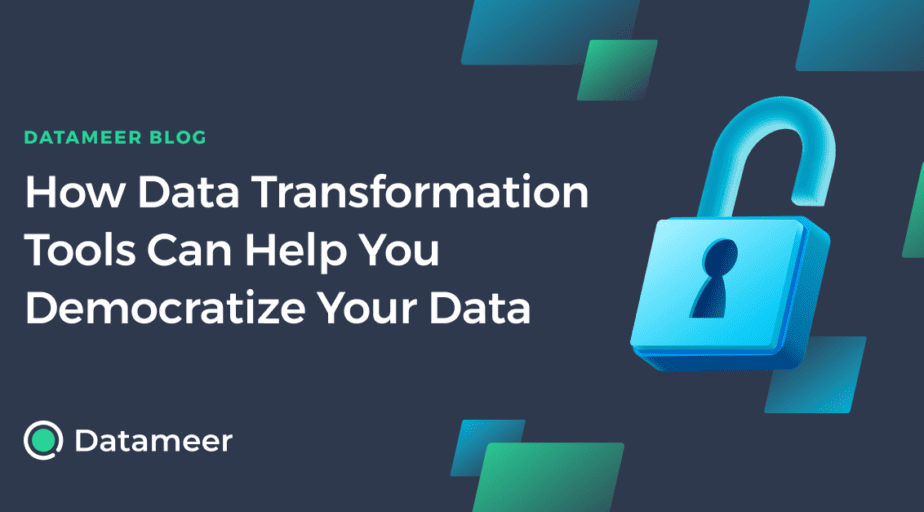How Data Transformation Tools Can Help You Democratize Your Data
- Jeffrey Agadumo
- August 3, 2023

Data democratization isn’t a term that was popular prior to a few years ago. Back then, data analytics was a technical skill reserved for a selected few who had learned to speak the language of data -usually SQL – and utilize its complex tools and methods to transform data, analyze it and reach valuable insights.
However, the exponential advancements in technology ensured that this wouldn’t be the case for long. Now the data tools at our disposal have created a self-service analytics era like we haven’t seen before, proving that those days are gone.
This blog outlines the ways that data transformation tools can foster data democratization in your organization and the strategies that you can implement to democratize your data.
Then stick around and discover your next steps to a data democracy.
Understanding Data Democratization
Data democratization makes data accessible and understandable to all individuals within an organization, irrespective of their technical expertise. Previously, data was limited to IT and data specialist teams, hindering others from leveraging data for decision-making.
The problem with relying on technical analytics teams to handle data is their overwhelming workload due to numerous requests from other departments to query specific data segments. And without a proper data democratization strategy, granting data access to departments like marketing or sales can lead to errors and inconsistent data formats.
However, the paradigm has shifted, and businesses now value empowering every team member with data-driven insights, leading to informed decision-making and data-driven outcomes. Data democratization fosters a culture of efficiency and better outcomes.
To implement a data democratization strategy, you must:
- Set clear objectives and goals for data democratization.
- Assess and optimize data infrastructure, ensuring security and transparency.
- Choose user-friendly data analytics and visualization tools.
- Provide data literacy training for employees at all levels.
- Encourage collaboration to promote a data-driven culture.
So how can data transformation tools help?
Features of Transformation Tools For Data Democratization
Data democratization is an ongoing process that requires efficient tools to streamline each step of the way, especially the crucial data transformation process. The transformation process often requires the most expertise as it involves changing the format, structure, and value of data as needed to make it more usable and accessible.
The ideal data transformation tool excels at:
1. Facilitating Self-Service Analytics
One of the core principles of data democratization is enabling self-service analytics. A reliable transformation tool empowers users with the ability to explore and analyze data on their own terms without relying on data specialists. This autonomy fosters a culture of data-driven decision-making across all levels of an organization.
2. Streamlining Data Integration
Data transformation tools excel at integrating data from various sources. They act as facilitators that effortlessly collect, combine and organize data from different systems, databases, and applications. By doing so, these tools eliminate data silos while maintaining access control measures and ensuring that all relevant information is accessible from a centralized platform.
3. Data Cleansing and Enrichment
Raw data can be messy and filled with inconsistencies. Data transformation tools play a vital role in cleansing and enriching the data by identifying errors, removing duplicates, and standardizing formats. This process results in clean, reliable data forming the foundation for accurate analyses and decision-making.
4. Ensuring Data Quality and Accuracy
The success of data democratization relies heavily on the quality and accuracy of the data being shared. Data transformation tools implement data validation techniques to ensure that the data is consistent, valid, and up-to-date. This instills confidence in decision-makers, as they know they can trust the data at their disposal.
5. Data Visualization and Interpretation
To democratize data effectively, it is essential to present it in a visually compelling manner that is easy to comprehend. Data transformation tools often come equipped with advanced data visualization capabilities, enabling users to create interactive dashboards, charts, and graphs. This empowers non-technical users to interpret data effortlessly and gain actionable insights.

Breaking Usability Barriers With Datameer and Snowflake.
To implement a data democratization strategy, you’ll need multiple tools in your data stack tailored to your company’s needs.
Snowflake offers data integration, seamless scalability, and concurrent access and performance, making data accessible to different teams across departments and promoting data-driven decision-making.
Datameer complements Snowflake with a no-code alternative, data cataloging, and collaboration features. Non-technical users can perform complex analyses, fostering knowledge sharing.
Snowflake and Datameer work seamlessly together, eliminating the need for data migration and simplifying data democratization and utilization.
Sound like what you need?


